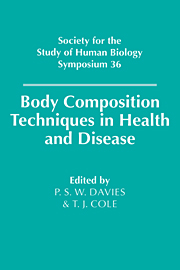Book contents
- Frontmatter
- Contents
- List of contributors
- 1 Application of dual-energy X-ray absorptiometry and related techniques to the assessment of bone and body composition
- 2 In vivo neutron activation analysis: past, present and future
- 3 Magnetic resonance imaging for the assessment of body composition
- 4 Multi-frequency impedance as a measure of body water compartments
- 5 Body composition assessed by electrical conductivity methods
- 6 Body composition in malnutrition
- 7 Influence of body composition on protein and energy requirements: some new insights
- 8 Prediction of adult body composition from infant and child measurements
- 9 Assessment of body composition in the obese
- 10 The role of body physique assessment in sports science
- 11 The assessment of the body composition of populations
- 12 Changes in approach to the measurement of body composition
- 13 Multi-compartment models for the assessment of body composition in health and disease
- 14 The future of body composition research
- Index
5 - Body composition assessed by electrical conductivity methods
Published online by Cambridge University Press: 18 September 2009
- Frontmatter
- Contents
- List of contributors
- 1 Application of dual-energy X-ray absorptiometry and related techniques to the assessment of bone and body composition
- 2 In vivo neutron activation analysis: past, present and future
- 3 Magnetic resonance imaging for the assessment of body composition
- 4 Multi-frequency impedance as a measure of body water compartments
- 5 Body composition assessed by electrical conductivity methods
- 6 Body composition in malnutrition
- 7 Influence of body composition on protein and energy requirements: some new insights
- 8 Prediction of adult body composition from infant and child measurements
- 9 Assessment of body composition in the obese
- 10 The role of body physique assessment in sports science
- 11 The assessment of the body composition of populations
- 12 Changes in approach to the measurement of body composition
- 13 Multi-compartment models for the assessment of body composition in health and disease
- 14 The future of body composition research
- Index
Summary
Introduction
Electrical conductivity offers the prospect of a rapid, safe, non-invasive, non-contact method for assessing body composition in humans. It was originally conceived in the USA in 1973 for the rapid assessment of the fat and lean proportions of meat packages, carcasses and livestock. The electronic meat measuring equipment (EMME) was adapted for human measurement in the early 1980s and renamed TOBEC. This operates on the principle that the impedance of a radiofrequency coil is changed when a human body is inserted and the change of impedance is related to the volume of body electrolytes. This was further developed in the mid 1980s to a scanning facility, in which the change of coil impedance as a function of the position of the subject was Fourier analysed to attempt to eliminate the influence of body shape on the estimate of fat-free mass. An alternative approach, named the tissue resonant impedance monitor (TRIM), was pioneered at the University of Swansea, Wales. The change of radiofrequency resulting from the insertion of the subject into a helical coil was related to the subject's lean body mass. This principle has been developed further at Leeds General Infirmary into a scanning facility driven with a free-running oscillator known as electromagnetic resonance (EMR). The average frequency shift that occurred when a subject was traversed completely through the coil was related to the subject's water space (r = 0.87). Subsequent analysis showed excellent correlation between frequency shift and surface area in calibration phantoms (r = 0.998), suggesting that only superficial induction of eddy currents was occurring and that the measurement was therefore relative to water at the surface.
- Type
- Chapter
- Information
- Body Composition Techniques in Health and Disease , pp. 57 - 70Publisher: Cambridge University PressPrint publication year: 1995
- 2
- Cited by



